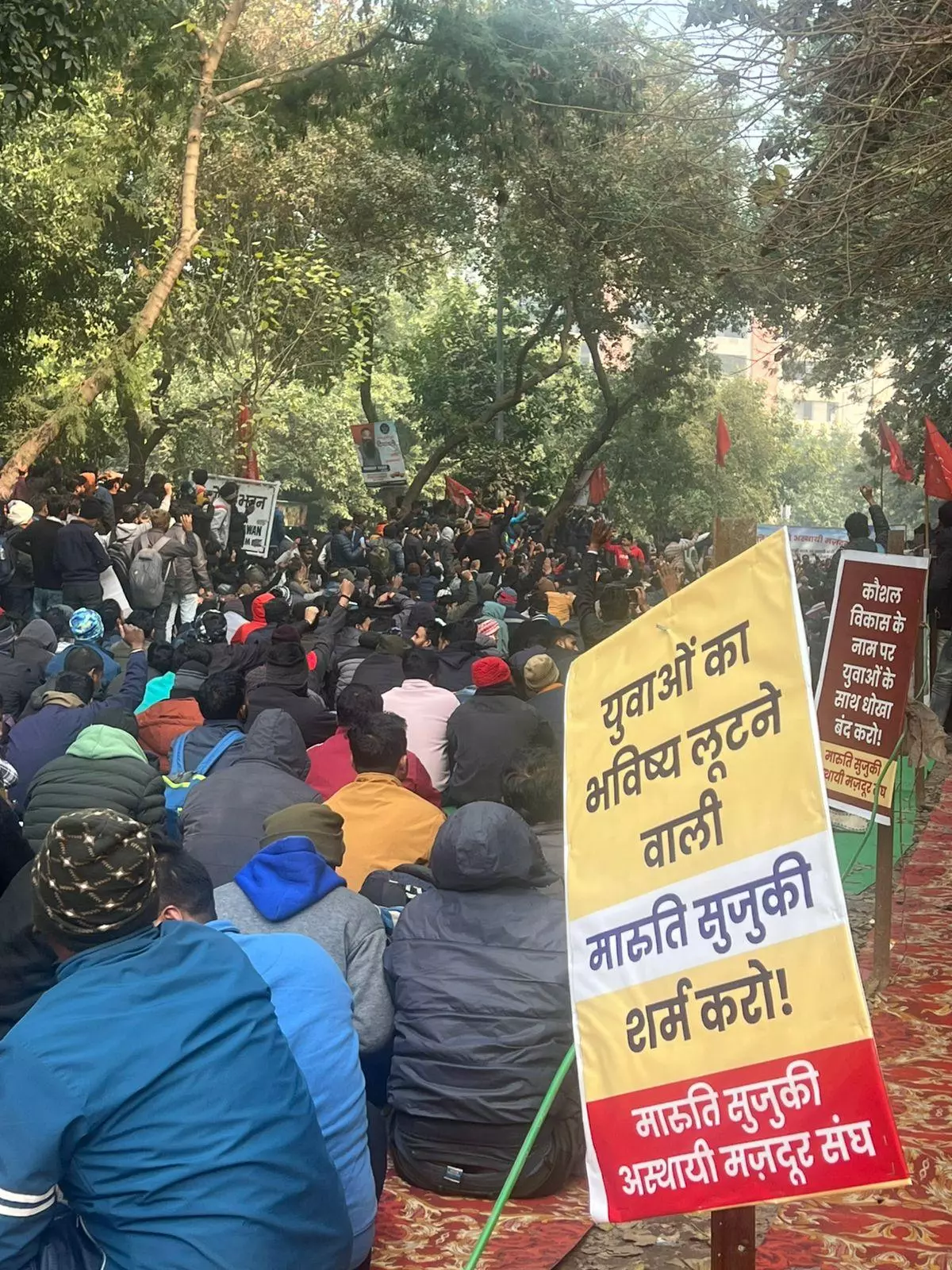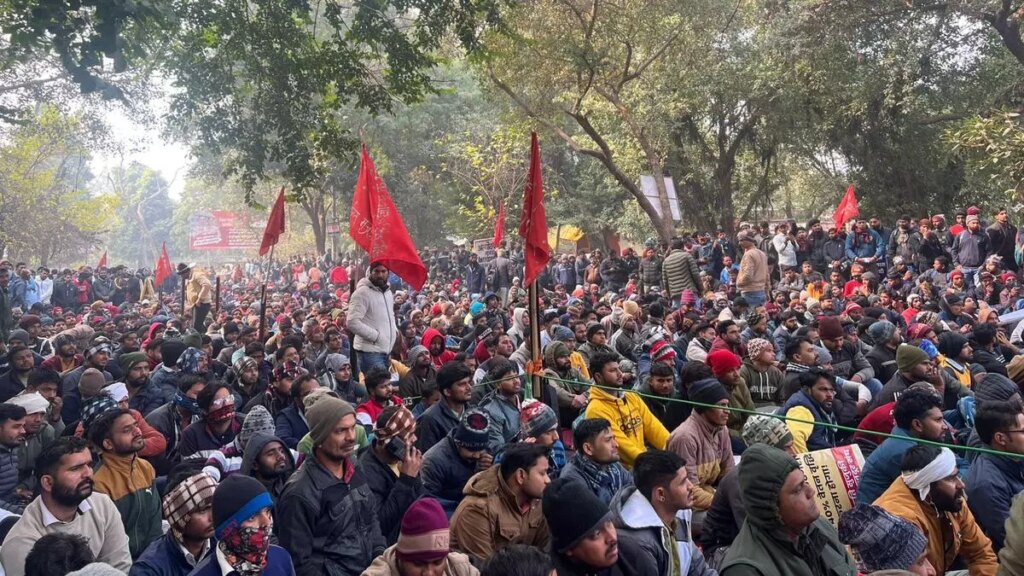It was intended to be a peaceful protest on January 30, Gandhi Jayanti—a sort of culmination of a four-month-long relay agitation by a section of former and current workers of Maruti Suzuki India Ltd. (MSIL) against the carmaker’s alleged illegal and unethical labour practices. Rallying under the aegis of the Maruti Suzuki Struggle Committee, the workers had been protesting peacefully in Haryana’s Manesar, an industrial hub. One of their main demands was the regularisation of contract workers and disbursement of salaries at par with permanent employees.
A notice for the January 30 meeting had been given to the administration in advance. The protest was to take place with support from other parts of the industrial belt of Gurugram and Manesar. A demand charter had been submitted to both the Haryana administration and the MSIL management.
A day earlier, the State police had dispersed workers from the protest site, citing law and order issues. They removed banners and posters, erasing all traces of the agitation. Frontline was warned not to take photographs of the shamiana, emptied of workers, but where policemen lounged. When the police were told that the workers had a court order with permission to protest, they feigned ignorance saying that Section 144 (Section 163 of the Bharatiya Nagarik Suraksha Sanhita) had been imposed in the area.
The management had earlier sought an injunction from the district court to “restrain” the protesters within 500 metres of the boundary wall of its three plants in Gurugram district: specifically, to prevent the workers from holding the meeting outside the company premises on January 30 and 31. The management claimed that the protesters were “in the process of initiating strikes and carrying out processions and protesting” outside the premises on those dates.
Also Read | How Maruti Suzuki tried to turn men into machines at Manesar
MSIL management said that the Maruti Suzuki Asthayi (non-permanent) Mazdoor Sangh (a union formed in early January, exclusively representing the interests of contract workers) had been “actively indulging in activities to call in a maximum number of people on these dates to protest against the company, and there was a possibility of violence and aggravation” that could affect the functioning of the company. The court, after assurances from the Mazdoor Sangh, directed it to hold its protests nonviolently at least 500 m away from the boundary wall of the company’s plants, gates, and properties; not to interrupt the smooth functioning of the day-to-day activities of the company; and not to come in the way of the entry and exit of employees. But despite the court orders, the police barred the workers from congregating.
The Advisor-Vigilance employed with the company registered an FIR late on January 29 against prominent members of the Struggle Committee for “impersonation, duping, causing fraud and cheating the gullible public in the name of providing fresh jobs, reinstatement of dismissed employees providing permanent/regular jobs to the contractual employees by misrepresenting themselves as authorized persons of Maruti Suzuki company”.
In October 2024, when a group of former employees and casual workers demanded reinstatement, pay parity, and other rights; they pitched a tent close to the Manesar Tehsil office. “We thought political parties would respond as the Haryana Assembly election was held in the same month. But little happened,” said one member of the Struggle Committee. For four months, they held on, in the form of relay protests. Each day, after they completed their work, contract and casual workers from MSIL would join in solidarity with their laid-off colleagues. The principal demand was much the same: the regularisation of contract workers in the existing plants and the reinstatement of sacked permanent and contract workers who had been jailed and later acquitted by a court. They also wanted the company to deploy the laid-off workforce in its new plant in nearby Kharkhauda, also in the industrial belt.
As contract workers formed the bulk of the company’s workforce and were most susceptible to getting fired, they formed the Maruti Suzuki Asthayi (non-permanent) Mazdoor Sangh on January 10.
2012: A death and 150 arrests
This issue has its origins over a decade ago, in 2011-12, the year MSIL workers struck work demanding an independent union. The protest was suppressed, but the workers managed to get their own union. The new element this time was that contract workers and a section of permanent workers had decided to renew their protests around concerns that reflected working conditions across the auto sector and other industries.
On July 18, 2012, a manager who was apparently sympathetic to the workers, died in a clash between employees and members of the management. Even though the exact culpability would never be established, criminal charges were filed against 213 workers, many of them union leaders. Of these, 150 workers were jailed. The company resorted to mass termination. As many as 546 permanent and 1,800 contract workers were laid off.
Later, a Special Investigative Team of the Haryana Police investigated the matter further and exonerated 426 permanent workers and 1,800 contract workers. Five years later, in 2017, of the 150 who were jailed, 31 were convicted, and 13 workers were awarded life sentences for murder and attempted murder; 117 workers were acquitted. The company did not reinstate those who were sacked. “Both the management and the government tried to portray us as criminals. The exoneration proved them wrong,” said Khushi Ram, a former permanent employee of MSIL, and a member of the Struggle Committee and also of the Maruti Asthayi Mazdoor Sangh.
But the union took a hit from the arrests of 2012. The priority now was to help their jailed colleagues. In April 2014, the company declared union elections. “This was unilaterally done. Our workers were still in jail and there were several whose services were terminated. We agreed to the process,” said Khushi Ram. “The union was formed but the sacked workers were left out of the process.”

At a protest against alleged illegal and unethical labour practices of Maruti Suzuki India Ltd, at Manesar, Haryana.
| Photo Credit:
By Special Arrangement
When 117 workers were acquitted, a demand rose that they should be reinstated as they had been falsely charged and jailed, he added. “It has been a continuous process; of fighting the management, the administration, and then in the courts. Two of the 13 workers sentenced for life died, and one of the workers died due to delayed treatment for cancer,” said Khushi Ram. And so, the protests continued.
In 2011-12, central trade unions such as the Centre of Indian Trade Unions (CITU), the All India Trade Union Congress, and the Hind Mazdoor Sabha had played an important role in highlighting the right of workers to form unions. Satbir Singh, vice-president of CITU, Haryana, told Frontline that the company should have reinstated the workers it sacked. The majority were still jobless. “When 117 workers were acquitted by the court, why didn’t the management take them back?” he asked.
Reflecting on the events that led up to the incident in 2012, Khushi Ram said that there was worker unrest on many grounds: not letting workers form an independent union, the differential categorisation of skilled workers to deny pay parity, and the hiring of contract workers in large numbers. Even though the workers got their independent union, which was recognised by the management and the Labour Department, there were issues that were still not resolved.
In 2011, Khushi Ram recalls, the main demand was to form an independent union. Workers struck work, which led to the sacking of many non-permanent workers. Even in that period, there were different categories of workers: permanent, trainee and contract workers, and apprentices. Even though the skill levels of contract workers matched those of permanent workers, it suited the company to keep the majority of workers on contract. The liabilities were fewer. “Our target was to keep all workers together. But the management was against it. A civil dispute ultimately turned into a criminal dispute,” he said.
After the 2012 incident, 18 workers were sent joining letters as well, but they were in jail, he said. “The company said they could join but the police arrested them. Wonder what this farziwaada [fraud] is going on,” said Khushi Ram.
2005: The origin story
In the automobile sector in the National Capital Region, there have been militant struggles beginning with the widely televised and infamous police action on workers in 2005. Unions concede that there have been many achievements over the years with workers succeeding in forming unions. Organising themselves in the industrial belt of Gurugram, a trade union leader said, was not easy, given the huge geographical area, resistance by management to wage-related issues, and the hostile attitude of the government.

The shamiana was emptied of protesting workers and occupied by Haryana Police, in Manesar, Haryana, on January 29, 2025.
| Photo Credit:
T.K. Rajalakshmi
Workers affiliated to the Struggle Committee said they had conducted surveys within the plants they worked in and found there were multiple categories across industrial units. In MSIL itself, Khushi Ram said that 83 per cent of all workers in the three plants were non-permanent whereas only 17 per cent were permanent. Production, therefore, is entirely dependent on the non-permanent workers. However, unions were comprised of permanent workers mostly.
Back to the future
On November 18, 2024, the Struggle Committee sent a letter to the Labour Department on behalf of contract workers. Initially, the committee found that workers were reluctant to associate with it fearing persecution. Many, after all, had hopes of becoming “permanent”. They were apprehensive that by associating with a union, these prospects could be jeopardised. But when the union called a meeting of former workers, both permanent and contract, the response was overwhelming.
Among the former contract workers, Khushi Ram said there was not a single person who was earning more than Rs.15,000 in the automobile sector.
Also Read | The steady immiseration of labour
The Asthayi Sanghcalled for a larger protest on January 30, with workers expected to come in from various parts of the industrial belt: but the administration did not allow the workers to assemble. “The Haryana government does not want to upset the company. Neither does the Labour Department do anything for us,” said committee members.
“Our lives have been ruined but our children shouldn’t suffer the same. In general, auto companies employ workers at a young age and keep them for almost five years on grounds of skilling them. After that, they don’t regularise or recruit all of them. They ‘retire’ the workers at the age of 25 years. Where will this youth go?” workers told Frontline.
Frontline contacted the MSIL management for a response on the protest but has so far, receive none.
Source:https://frontline.thehindu.com/the-nation/manesar-maruti-suzuki-contract-workers-protest-labour-rights-gurugram-haryana-automobile-sector/article69176238.ece

